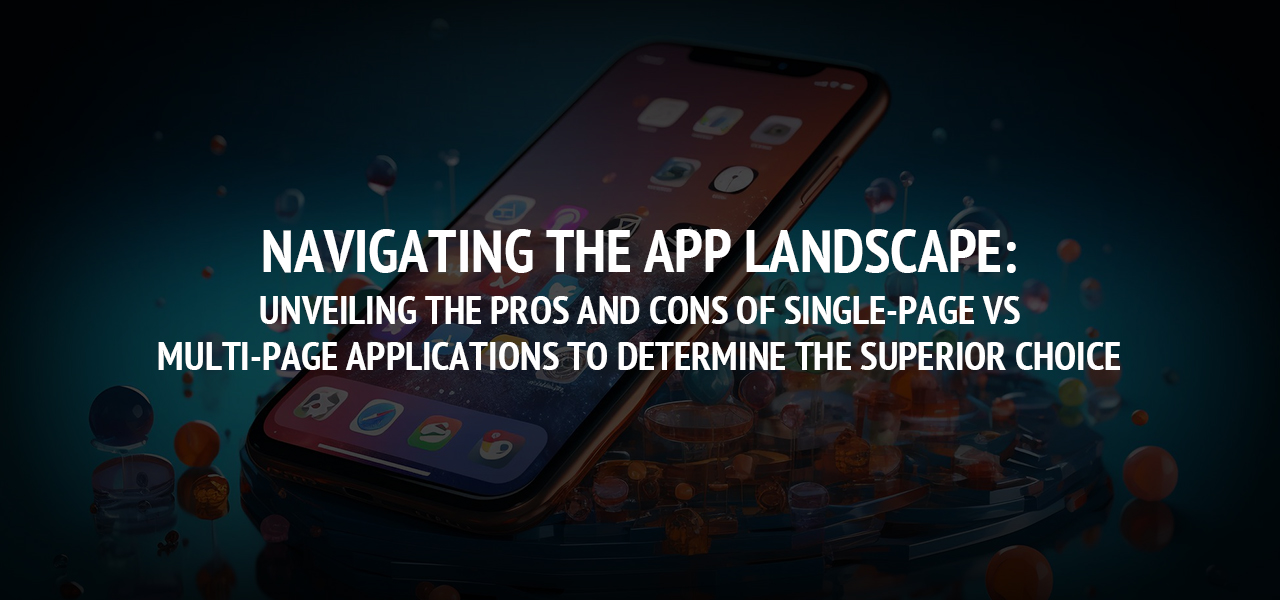Navigating the App Landscape: Unveiling the Pros and Cons of Single-Page vs. Multi-Page Applications to Determine the Superior Choice

Introduction
In the vast realm of web development, Single-Page Applications (SPAs) and Multi-Page Applications (MPAs) stand as two prominent structures. These structures play a pivotal role in determining the user experience and overall performance of an application. Choosing the right one isn't just a technical decision; it's a strategic move that impacts how users interact with your digital offerings.
Understanding Single-Page Applications (SPAs)
Single-page applications, or SPAs, are like the streamlined express lanes of the digital world. They load once, and from there, users smoothly navigate without constant page reloads. Think of it as ordering your favorite pizza with just a click, and everything unfolds seamlessly. That’s the power of custom app store optimization services. They make jobs easier for you.
SPAs are websites or applications where the content dynamically loads on a single page. The user interacts with the app, and voila, the content updates in real time without jumping to a new page. It’s like having a conversation without interruption.
Key Features and Advantages
- Improved User Experience: Imagine scrolling through a social media feed without the interruptions of new pages loading. SPAs provide a fluid and uninterrupted user experience, making interactions feel natural.
- Faster Load Times: SPAs load faster because they fetch data in the background, making subsequent interactions swift. It’s like having your coffee ready before you even reach the counter.
- Seamless Navigation: Navigating through SPAs is like taking a stroll in the park. It’s smooth, with no abrupt stops, providing users with a pleasant and engaging journey.
Exploring Multi-Page Applications (MPAs)
Now, let's turn our attention to Multi-Page Applications (MPAs), the traditional yet effective counterparts to SPAs. MPAs, like a well-organized library, present content across multiple pages, each serving a specific purpose.
Multi-Page Applications are like a well-organized book, with each page dedicated to a specific chapter. When you navigate through an MPA, you're essentially turning pages to access different content. It’s the classic approach that still stands strong in the digital age.
Key Features and Advantages
- SEO Friendliness: MPAs have a leg up in terms of search engine optimization. Search engines find it easier to index multiple pages with distinct URLs, making it simpler for users to discover your content. It’s like having your business listed in every relevant directory.
- Simplicity in Development: Developing MPAs is akin to building a modular structure. Each page is like a separate building block, making it easier for developers to manage and update specific sections without affecting the entire application. It’s the architectural simplicity that fosters efficiency.
- Better Fallback for Non-JavaScript Users: Unlike SPAs, MPAs ensure a smoother experience for users with disabled JavaScript. When the scripting language takes a backseat, MPAs still provide essential functionalities, ensuring that your content remains accessible to all. It’s like having a reliable Plan B.
The Pros and Cons Comparison
Let's delve into the nuts and bolts of Single-Page Applications (SPAs) and Multi-Page Applications (MPAs), comparing their performance, user experience, development, maintenance, and SEO aspects with respect to the custom app store optimization services.
Performance
- Speed and Load Times:
- SPAs boast lightning-fast load times, as they fetch data on the go, reducing wait times for users. It's like a swift elevator ride to your desired floor.
- On the flip side, MPAs might have slightly slower initial load times due to loading separate pages, but subsequent page navigation tends to be quicker.
- Resource Consumption:
SPAs can be resource-intensive, loading all necessary assets upfront. It's akin to a prepared buffet, where everything is ready in advance.
MPAs are lighter on initial resource consumption, loading only the required elements per page. Think of it as ordering a-la-carte rather than the entire menu.
User Experience
- Navigation Fluidit
SPAs excel in providing a seamless user experience, akin to flipping through pages in a well-bound book, without interruptions.
MPAs, with their distinct page structure, offer a more traditional but equally smooth navigation experience, like turning pages in a magazine.
- Responsiveness
SPAs shine in responsiveness, offering dynamic content updates without refreshing the entire page. It's like a chat that evolves in real-time.
MPAs maintain responsiveness by loading only the necessary page elements, ensuring a snappy experience for users.
Development and Maintenance
- Ease of Development
SPAs can be more complex to develop, akin to crafting a dynamic orchestra where different components need to synchronize seamlessly.
MPAs, with their modular structure, offer a straightforward development process, making it easier for teams to collaborate on different sections independently.
- Scalability
SPAs, once developed, can face challenges in scalability due to the heavy initial load. It's like managing a bustling city with continuous traffic.
MPAs, with their modular approach, often fare better in terms of scalability, allowing for easier expansion as needed.
SEO Friendliness
- SPAs and SEO Challenge
SPAs may face challenges in SEO due to the initial reliance on JavaScript for content rendering. Search engines might find it harder to index dynamic content.
To tackle this, developers often implement server-side rendering or pre-rendering techniques to enhance SPA SEO.
- MPAs and SEO Strengths
MPAs, with their individual page URLs, play well with search engines. It's akin to having each chapter of a book listed separately, making it easier for users to discover your content.
Determining the Superior Choice
As we stand at the crossroads of Single-Page Applications (SPAs) and Multi-Page Applications (MPAs), the decision-making process becomes critical. Let’s explore the criteria, project requirements, and future trends to help you make an informed choice.
Criteria for Decision Making
Consider factors like the nature of your content, user interactions, and project goals. For dynamic applications requiring real-time updates, SPAs may shine. Meanwhile, if SEO and modular development are paramount, MPAs offer a reliable path.
Consideration of Project Requirements
Understanding your project's specific needs is key. SPAs, with their sleek user experience, might be ideal for interactive apps like social media platforms. On the other hand, if your content is vast and SEO visibility is crucial, MPAs might be the way to go.
Future Trends in App Development
Stay ahead of the curve by considering emerging trends. Progressive Web Apps (PWAs), which combine the best of both worlds, are gaining traction. Evaluating how well SPAs and MPAs align with these evolving trends can guide your decision-making.
Best Practices
Now, let's delve into best practices for optimizing and enhancing the performance of SPAs and MPAs.
Optimization Techniques for SPAs
- Lazy Loading: Implement lazy loading for non-essential components, ensuring faster initial load times.
- Code Splitting: Divide your code into smaller, manageable chunks to enhance performance.
- Caching Strategies: Leverage caching mechanisms for static assets to reduce server load.
Strategies for Enhancing MPA Performance
- Minimize HTTP Requests: Reduce the number of elements on each page to streamline performance.
- Compression Techniques: Implement Gzip or Brotli compression to decrease file sizes and boost loading speed.
- Asynchronous Loading: Load non-essential resources asynchronously to prevent bottlenecks.
Tips for Seamless Transitioning Between SPAs and MPAs
- Hybrid Approach: Consider a hybrid approach where certain sections of your app operate as SPAs, while others follow the MPA structure.
- Use of Navigation Libraries: Employ navigation libraries to facilitate smooth transitions between different sections.
- Maintain Consistent Design: Ensure a cohesive design across SPAs and MPAs for a seamless user experience.
Key Takeaways
SPAs excel in user experience and dynamic content, while MPAs offer SEO benefits and modular development. The decision hinges on project requirements and future trends.
There’s no one-size-fits-all solution. Tailor your choice based on the unique demands of your project, considering user experience, SEO, and emerging trends.
In the ever-evolving landscape of web development, stay agile. Regularly assess your application's performance, user feedback, and technological advancements, adapting your approach as needed.Incorporating strategies from a reputable app store optimization services can further enhance your application's visibility and reach in the competitive online marketplace, ensuring sustained growth and success.
About The Author
Related Blog
View All-
3 great financial apps and services to start with if new to investment
Want to start saving/investing some of your money in 2020, and putting it towards something more productive? Check out this shortlist of financial apps and services that might be a good place to start. Plum Essentially an AI ‘robot’ that assesses ...
-
Unveiling the Power of Online Marketplace Development: A Comprehensive Guide to Choosing the Perfect Company
The Rising Tide of Online Marketplaces In the digital era, online marketplaces have emerged as a force to be reckoned with. The explosion of eCommerce and the continual rise of digitization have laid fertile groundwork for these platforms. The emergence of behemoths ...







